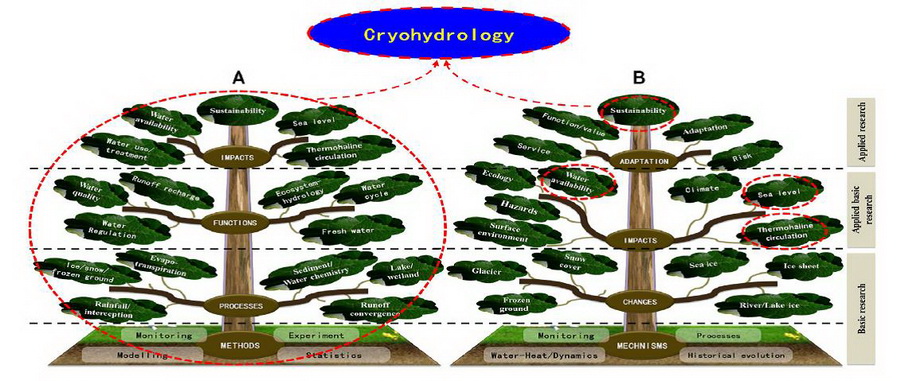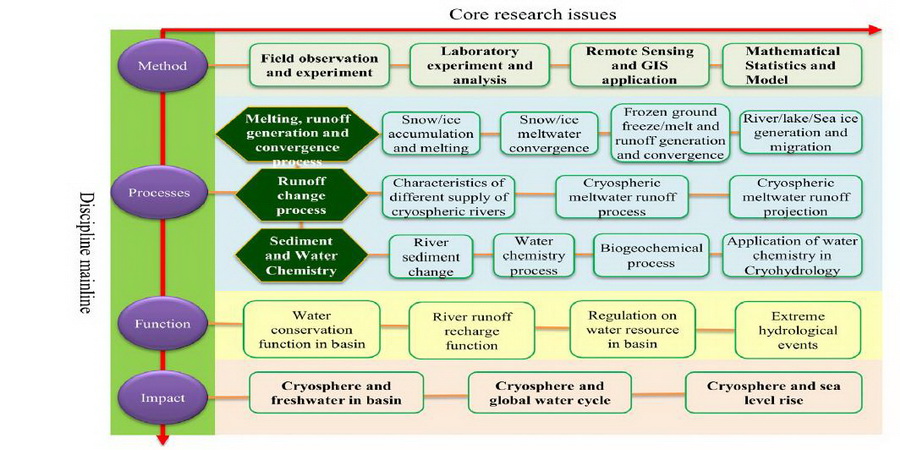Scientists Summarize Hydrological Basis and Discipline System of Cryohydrology
Updatetime:2020-12-28From:
【Enlarge】【Reduce】
Cryohydrology was referred to as hydrology involving at low temperatures, which broadened with the development of cryospheric science and now involves hydrological processes of various cryosphere elements systematically coupled with river basin hydrological processes. However, limited studies have introduced the characteristics and discipline connotations of cryohydrology from a perspective of cryospheric science.
Recently, Prof. DING Yongjian from the Northwest Institute of Eco-Environment and Resources (NIEER), Chinese Academy of Sciences (CAS) and his team presented an overview on the evolution of the cryohydrology and analyzed its hydrological basis and discipline system, to accurately understand the hydrological effects of different cryosphere elements and the overall hydrological process of the basin under the influence of climate change.
In this study, by condensing the core academic thoughts behind cryohydrology, they attempted to comprehensively construct its research framework from the succession of the discipline, the common hydrological characteristics of the cryosphere, the research content and the discipline’s constituents.
They also pointed out that cryohydrology was developed based on traditional hydrology for a single element of the cryosphere and focused on the hydrological functions of the cryosphere and its impact on the water cycle and water supply to other spheres (Fig 1).
The hydrological basis of cryohydrology can be summarized as water conservation, runoff recharge, and hydrological regulation. In detail, the water conservation function is primarily expressed as "source of freshwater" and "cold and wet islands", the runoff recharge function is concerned with water supply, and the regulation function is effective at intra- and inter-annual scales. The core research issues of cryohydrology are research methods, hydrological processes, watershed functions, and regional impact (Fig 2).
Cryohydrology aims to deepen the understanding of the theoretical and cognitive levels of its mechanisms and processes, accurately quantify the hydrological functions of the basin, and promote understanding of the ecological and environmental impacts of the cryosphere. This study will contribute to understand the integrated hydrological functions of the different elements of the cryosphere at the regional or global scale.
This work has been published on Frontiers in Earth Science recently entitled with “Hydrological basis and discipline system of Cryohydrology: from a perspective of Cryospheric Science”. Prof. DING Yongjian and Prof. ZHANG Shiqiang are the first and corresponding author, respectively.

Fig 1 Research content tree of Hydrology(a) and (b) Cryospheric Science (after Qin et al., 2018) as well as and the relationship between Hydrology, Cryohydrology and Cryospheric Science. Note that Cryohydrology focuses on the water cycle and water availability, and the intersection between Cryospheric Science and Hydrology. (Image by DING Yongjian)

Fig 2 The core research issues of Cryohydrology along the discipline mainline which primarily include method ( in-situ observation, laboratory experiment, remote sensing application, and statistics/model), processes (melting, runoff generation and convergence, runoff changes, sediment and chemistry), function (water conservation, runoff recharge, regulation, extreme events), and impact (freshwater in basin, global water cycle, and sea level rise). (Image by DING Yongjian)
Contact:
DING Yongjian
E-mail: dyj@lzb.ac.cn
State Key Laboratory of Cryospheric Sciences, Northwest Institute of Eco-Environment and Resources, Chinese Academy of Sciences (CAS), Lanzhou 730000, China.
Appendix




